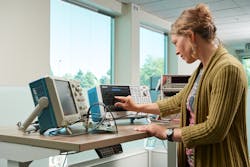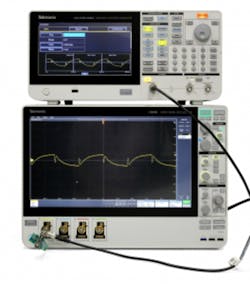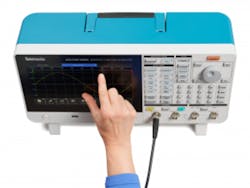Electronic test & measurement engineers have been in a constant state of upgrading ever since such T&M has been needed. Newer, better testing equipment and devices have enabled more accurate testing & measurement, more factors that can be tested, the ability to test exponentially more devices at one time, faster results and test setup time, and more.
But with each new equipment upgrade has come a learning curve. New equipment features and capabilities take time to train on and learn, which can slow productivity when making the transition to a new solution.
In late October Beaverton, OR-based T&M device provider Tektronix launched one of its latest innovations: the AFG31000 Arbitrary Function Generator. Packed with features including a 9-inch touchscreen, a newly redesigned user interface, and the ability to monitor and display DUT waveform without the need for additional cables or instruments (a feature called InstaView), Tektronix took steps to ensure that the AFG31000’s new capabilities wouldn’t create a learning hurdle for engineers simply looking for a better way to test.
I was given a product demonstration by Eric Yang, senior product planning manager at Tektronix, and afterward, I asked him to elaborate on test engineers’ demand for ease-of-use when it comes to new equipment and how Tektronix met that challenge with its new AFG solution.
Mike Hockett, EE Editor-in-Chief: The electronic test & measurement industry appears to be making great strides towards increasing ease-of-use of instruments, and the AFG31000 is an example of that. What kinds of pain points do you see engineers talking about when it comes to test setup, or specifically when using AFGs?
Eric Yang, Tektronix: Researchers and engineers want to focus on their job, first and foremost, and view test and measurement instruments as tools that help them accomplish their objectives. Because of this perspective, it’s incredibly important for them to minimize time spent on learning how to use an instrument and instead focus on generating value. They want tools that not only have the performance/functions they need, but also are easy and intuitive to use.
For AFG users specifically, they want to generate certain waveforms to stimulate their devices under test, but don’t want to read a manual to know where the setting/parameters they need are located or hunt through deep menu trees. Similarly, they don’t want to spend time learning how to use arb creation/edit software to compose the arbitrary waveforms at the sample level. We did a lot of work to understand where customers were running into roadblocks or spending unnecessary cycles, and looked for ways to optimize the user interface and implement features that would save our customers time and reduce their effort overall. This fits well with our overall mission as a company to help our customers innovate and bring world-changing technologies to market in less time.
MH: Of the AFG31000’s key features, which was the most difficult to develop/engineer, and why?
EY: InstaView technology stands out as something that was particularly difficult. We were the first company in the T&M industry to realize that this has been an ongoing pain point for AFG users. All current AFG offerings (including Tek’s) assume the devices under test have 50 ohm impedance and show the waveform amplitude and shape based on this assumption. If users are not aware of this, they may waste their test time on incorrect setups and get wrong results. If they’re aware of this, they would need to use a scope to test and verify. Once we identified the problem, we had to find an easy and cost-effective way (from the user’s point of view) to solve the problem. The product team invested considerable time on research and conducting lab experiments to find the best solution.
Lastly, we had to realize the solution in the product and optimize performance. InstaView technology speeds test setup by giving customers an easy way to see and verify the waveform at the DUT without needing a scope. Although it seems like an obvious pain point and need now, this was first time we (or anyone) has addressed this problem and devising an effective solution required real innovation and problem-solving.
About the Author





